x

هدف البحث
بحث في العناوين
بحث في المحتوى
بحث في اسماء الكتب
بحث في اسماء المؤلفين

اختر القسم
موافق


تاريخ الرياضيات

الاعداد و نظريتها

تاريخ التحليل

تار يخ الجبر

الهندسة و التبلوجي


الرياضيات في الحضارات المختلفة

العربية

اليونانية

البابلية

الصينية

المايا

المصرية

الهندية


الرياضيات المتقطعة

المنطق

اسس الرياضيات

فلسفة الرياضيات

مواضيع عامة في المنطق


الجبر

الجبر الخطي

الجبر المجرد

الجبر البولياني

مواضيع عامة في الجبر

الضبابية

نظرية المجموعات

نظرية الزمر

نظرية الحلقات والحقول

نظرية الاعداد

نظرية الفئات

حساب المتجهات

المتتاليات-المتسلسلات

المصفوفات و نظريتها

المثلثات


الهندسة

الهندسة المستوية

الهندسة غير المستوية

مواضيع عامة في الهندسة

التفاضل و التكامل


المعادلات التفاضلية و التكاملية

معادلات تفاضلية

معادلات تكاملية

مواضيع عامة في المعادلات


التحليل

التحليل العددي

التحليل العقدي

التحليل الدالي

مواضيع عامة في التحليل

التحليل الحقيقي

التبلوجيا

نظرية الالعاب

الاحتمالات و الاحصاء

نظرية التحكم

بحوث العمليات

نظرية الكم

الشفرات

الرياضيات التطبيقية

نظريات ومبرهنات


علماء الرياضيات

500AD

500-1499

1000to1499

1500to1599

1600to1649

1650to1699

1700to1749

1750to1779

1780to1799

1800to1819

1820to1829

1830to1839

1840to1849

1850to1859

1860to1864

1865to1869

1870to1874

1875to1879

1880to1884

1885to1889

1890to1894

1895to1899

1900to1904

1905to1909

1910to1914

1915to1919

1920to1924

1925to1929

1930to1939

1940to the present

علماء الرياضيات

الرياضيات في العلوم الاخرى

بحوث و اطاريح جامعية

هل تعلم

طرائق التدريس

الرياضيات العامة

نظرية البيان
Net
المؤلف:
Bouzette, S.; Buekenhout, F.; Edmond, D.; Gottcheiner, A.
المصدر:
"A Theory of Nets for Polyhedra and Polytopes Related to Incidence Geometry." Designs, Codes and Cryptography 10
الجزء والصفحة:
...
24-7-2021
1382
The word net has several meanings in mathematics. It refers to a plane diagram in which the polyhedron edges of a polyhedron are shown, a point set satisfying certain uniformity of distribution conditions, and a topological generalization of a sequence.
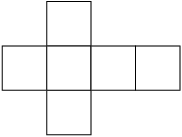 |
 |
The net of a polyhedron is also known as a development, pattern, or planar net (Buekenhout and Parker 1998). The illustrations above show polyhedron nets for the cube and tetrahedron.
In his classic Treatise on Measurement with the Compass and Ruler, Dürer (1525) made one of the first presentations of a net (Livio 2002, p. 138).
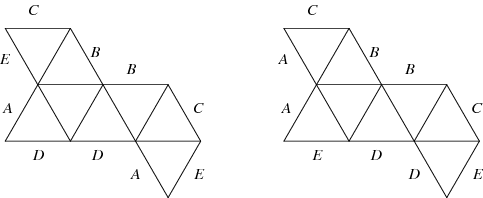
The net of a polyhedron must in general also specify which edges are to be joined since there might be ambiguity as to which of several possible polyhedra a net might fold into. For simple symmetrical polyhedra, the folding procedure can only be done one way, so edges need not be labeled. However, for the net shown above, two different solids can be constructed from the same net: the boat for the left figure and the octahedron for the right figure.
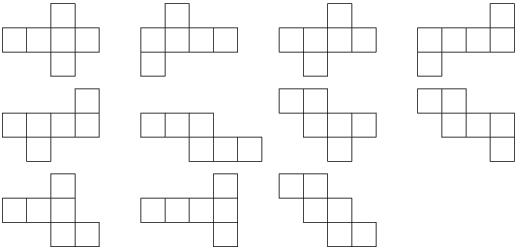
Polyhedron nets are not unique. For example, there are a total of 11 distinct nets for the cube (Buekenhout and Parker 1998, Malkevitch), illustrated above. Buekenhout and Parker (1998) compute the number of nets for all regular convex polytopes in dimension  . The results for the Platonic solids are summarized in the table below. For the Platonics, duals have the same numbers of unfoldings as their base solids (Buekenhout and Parker 1998).
. The results for the Platonic solids are summarized in the table below. For the Platonics, duals have the same numbers of unfoldings as their base solids (Buekenhout and Parker 1998).
| Platonic solid | number of nets |
| cube | 11 |
| dodecahedron | 43380 |
| icosahedron | 43380 |
| octahedron | 11 |
| tetrahedron | 2 |
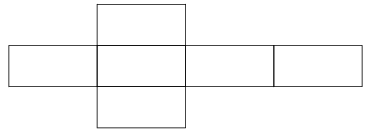 |
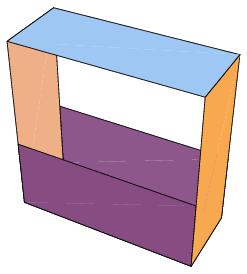 |
Not every plane diagram that resembles a net actually corresponds to a closed surface. For example, the "net" shown above corresponds to a basket with a handle but not a polyhedron.
Each net is uniquely determined by a spanning tree of the 1-skeleton of the polyhedron, i.e., the edges which are cut form a spanning tree of the vertices-edges graph (Buekenhout and Parker 1998).
It is conjectured (but amazingly not proved) that all convex polyhedra have nets (Shephard 1975, Malkevitch), a statement sometimes known as Shephard's conjecture.
Not all concave polyhedra do (the constituent polygons can overlap one another when a concave polyhedron is flattened out). The great dodecahedron and stella octangula are examples of a concave polyhedron which have nonself-intersecting nets. K. Fukuda has written routines which can unfold convex polyhedra into a planar net.
A  -net is a set of
-net is a set of 
 -dimensional points such that every half-open interval with volume
-dimensional points such that every half-open interval with volume  contains exactly
contains exactly  points. The Hammersley point set with
points. The Hammersley point set with  even and
even and  forms a
forms a  net.
net.
The term net also has a technical meaning as a generalization of a sequence, in which context it is also known as a Moore-Smith sequence. In this context, nets are used in general topology and analysis to imbue non-metrizable topological spaces with convergence properties. This artifice is needed only in spaces which are not first-countable, since sequences alone provide an adequate way of dealing with continuity for first-countable spaces. Nets are used in the study of the Riemann integral. Formally, a net of a set  is a mapping from a directed set
is a mapping from a directed set  into
into  .
.
REFERENCES:
Bell Laboratories. https://netlib.bell-labs.com/netlib/polyhedra/.
Bouzette, S.; Buekenhout, F.; Edmond, D.; Gottcheiner, A. "A Theory of Nets for Polyhedra and Polytopes Related to Incidence Geometry." Designs, Codes and Cryptography 10, 115-136, 1997.
Buekenhout, F. and Parker, M. "The Number of Nets of the Regular Convex Polytopes in Dimension  ." Disc. Math. 186, 69-94, 1998.
." Disc. Math. 186, 69-94, 1998.
Dürer, A. Unterweisung der Messung mit dem Zirkel und Richtscheit. 1525.
Fukuda, K. UnfoldPolytope Mathematica packages. https://www.cs.mcgill.ca/~fukuda/download/mathematica/.
Grünbaum, B. "Nets of Polyhedra." Geombinatorics 1, No. 2, 5-10, 1991.
Grünbaum, B. "Nets of Polyhedra II." Geombinatorics 1, No. 3, 5-10, 1991.
Grünbaum, B. "A Starshaped Polyhedron with No Net." Geombinatorics 11, 43-48, 2001.
Livio, M. The Golden Ratio: The Story of Phi, the World's Most Astonishing Number. New York: Broadway Books, 2002.
Malkevitch, J. "Nets: A Tool for Representing Polyhedra in Two Dimensions." https://www.ams.org/new-in-math/cover/nets.html.
Malkevitch, J. "Unfolding Polyhedra." https://www.york.cuny.edu/~malk/unfolding.html.
Malkevitch, J. "Le géométrie et la paire de ciseaux." La Recherche. No. 346, Oct. 2001. https://www.larecherche.fr/special/web/web346.html.
Schlickenrieder, W. Nets of Polyhedra. Ph.D. thesis. Berlin: Technische Universität Berlin, 1997.
Shephard, G. C. "Convex Polytopes with Convex Nets." Math. Proc. Camb. Phil. Soc. 78, 389-403, 1975.
Weisstein, E. W. "Polyhedron Nets on MathWorld." https://mathworld.wolfram.com/topics/PolyhedronNets.html.